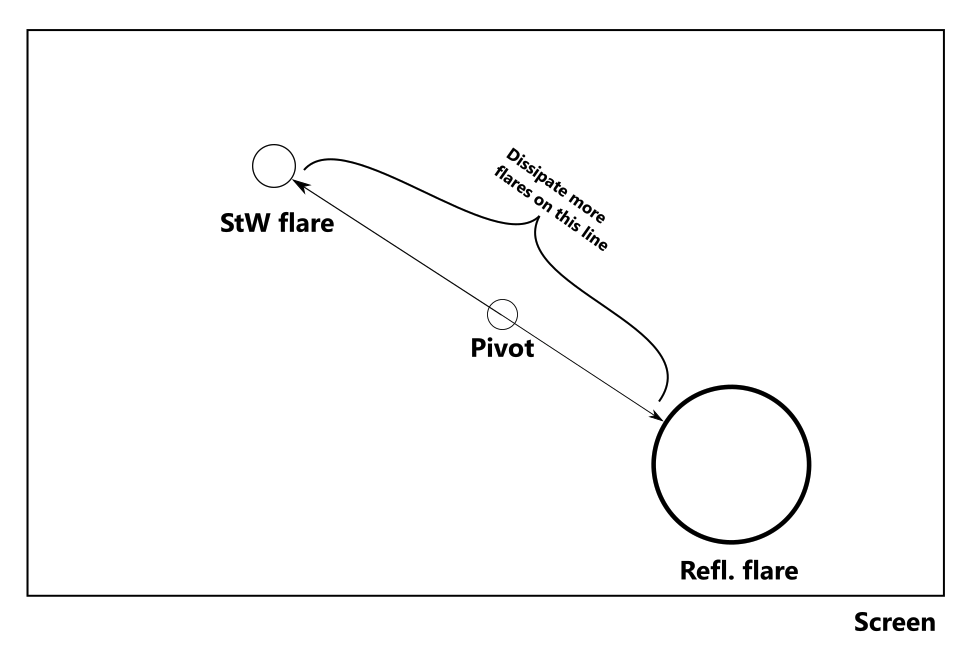So im trying to make lens flares. I have made a pretty good concept,
but I just dont know how to do the math part of it.
Basicly I just want to copy the lens flares from the unofficial pc port
of Half-Life: Decay (flare effect on maps: dy_uplink, dy_dampen).
Basicly I just need some help with the math part of it, by that I mean
calculating which angle should the lensflare effect be facing, and how
to calculate the distance between sprites/flares. Ive done some testing
and I came to the conclusion that TRI-API is drawing the flares in decay.
Help with these lens flare effects would be much appreciated.
[HELP] Lens flares
Created 4 years ago2020-11-12 13:02:44 UTC by
 Petko
Petko
Created 4 years ago2020-11-12 13:02:44 UTC by
![]() Petko
Petko
Posted 4 years ago2020-11-12 13:02:44 UTC
Post #344850
Posted 4 years ago2020-11-13 20:38:50 UTC
Post #344853
One simple method, perhaps, is to use TriAPI's "world to screen" projection of coordinates, if your "sun" is somewhere in 3D space and you're performing a traceline every few frames to determine its visibility.
That way, you'll get the 2D coords of the farthest lens flare, which can be the sun sprite itself. Then draw a series of sprites that are offset from each other, going towards a "pivot" (which is the centre of your screen). In other words, world-to-screen projection followed by multiple reflection around the screen centre.It's quite simple if we treat the pivot as position (0, 0). Let's say if WtS is (-8, 20), its reflected counterpart (let's call it R) would be (8, -20). And then you subdivide the "line" between them and put some more flares.
For example:
The other method is some trigonometry where we do this projection manually, that is, implementing a perspective projection matrix to convert some 3D coordinates into 2D. Then you do the same thing as above.
https://www.scratchapixel.com/lessons/3d-basic-rendering/perspective-and-orthographic-projection-matrix/building-basic-perspective-projection-matrix
That way, you'll get the 2D coords of the farthest lens flare, which can be the sun sprite itself. Then draw a series of sprites that are offset from each other, going towards a "pivot" (which is the centre of your screen). In other words, world-to-screen projection followed by multiple reflection around the screen centre.It's quite simple if we treat the pivot as position (0, 0). Let's say if WtS is (-8, 20), its reflected counterpart (let's call it R) would be (8, -20). And then you subdivide the "line" between them and put some more flares.
For example:
FlarePos1 = 0.75*WtS + 0.25*RFlarePos2 = 0.50*WtS + 0.50*RFlarePos3 = 0.25*WtS + 0.75*RThe other method is some trigonometry where we do this projection manually, that is, implementing a perspective projection matrix to convert some 3D coordinates into 2D. Then you do the same thing as above.
https://www.scratchapixel.com/lessons/3d-basic-rendering/perspective-and-orthographic-projection-matrix/building-basic-perspective-projection-matrix
Posted 4 years ago2020-11-13 21:54:41 UTC
Post #344854
@Admer456 Thanks for your help, I really appreciate it, it helps me by alot. By the way good luck with your programming video tutorials.
Posted 4 years ago2020-11-14 11:16:32 UTC
Post #344857
Ay, you're welcome. Speaking of tutorials, I think some basic TriAPI lens flares would be good tutorial material, for example on the TWHL Wiki.
You must be logged in to post a response.

